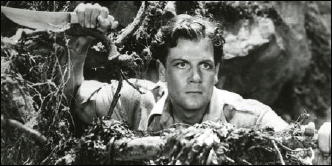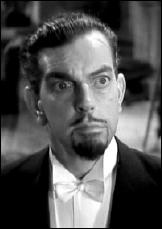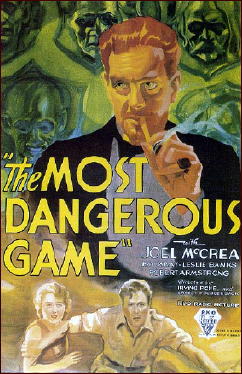Thu 12 Dec 2013
A Movie Review by Dan Stumpf: THE MOST DANGEROUS GAME (1932).
Posted by Steve under Action Adventure movies , Reviews[4] Comments

THE MOST DANGEROUS GAME. RKO Radio Pictures, 1932. Joel McCrea, Fay Wray, Robert Armstrong, Leslie Banks, Noble Johnson. Based on the story by Richard Connell. Directors: Irving Pichel & Ernest B. Schoedsack.
I caught Danger: Diabolik a week or so ago and enjoyed it but wasn’t overwhelmed, despite all the talk about it being just like a comic book on film. If you want a movie that looks like a 60s comic book, try Deadlier Than the Male, with Richard Johnson as Bulldog Drummond battling Elke Sommer. Some real Batman-sty!e visuals here.
Anyway, the extra features on the Diabolik DVD said a lot about making the movie look like a fumetti, which rang a bell, so I pulled out my tape of The Most Dangerous Game, and I have to say every frame looks like it was ripped from the cover of an old pulp magazine, dyed Black & White, and flung across the screen.

Splendid sets, atmospheric lighting, fast pace, and as I say, the constant lurid imagery. There’s a bit where Joel McCrae is in the dungeon freeing Faye Wray when a Chinese guy comes at them with a hatchet and McCrae turns and shoots him in one smooth motion. That image, of Wray in bondage, McCrae blasting away at the hatchet man amid the Gothic surroundings … well, it’s just one of thousands in this pulp-cover film.
I also want to add a word about Leslie Banks as the villain. Brilliant. It would have easy to play Count Zaroff as just suave and sadistic, but Banks adds a subtle layer of Twit. His Zaroff boasts and preens and leers, but there’s a hint of insecurity in his shifty eyes, a nervousness in the mouth…
It’s the same look one used to see on those pathetic and obviously chemical-dependent play-actor “sadists” in the old bondage films, or the face one saw on former President Bush when he talked about executions, and it adds a dimension to the part that goes way beyond its pulp-paper charms.

December 13th, 2013 at 11:17 am
I’ve often wondered if Cooper and Schoedsack offered the Bruce Cabot part in KING KONG to Joel McCrea. There’s a scene in this film where McCrea and Fay Wray cross the same log bridge that Kong shook several sailors off of in KING KONG.
December 13th, 2013 at 4:59 pm
Great film of the oft filmed story (Jesus Franco alone made several soft and not so soft porn variations). Game of Death with John Loder isn’t bad, but no where near as good as this, and Run For the Sun with Richard Widmark, Jane Greer, Trevor Howard, and Peter Van Eyck a tight well done not quite remake. Get Smart even did a really good episode based on Connell’s story.
Incidentally, considering the season, Richard Connell also wrote the story for Meet John Doe, and James Gleason’s newspaper editor in the film is named for him — not to mention a crooked politician named Hammett.
Connell did one mystery novel which was okay, but nothing special. But then when you write one of the most often reprinted stories ever penned it’s hard to top yourself.
December 15th, 2013 at 2:46 am
The Loder version used extensive footage from the original and Edgar Barrier was clearly doing Banks, and it’s hard to top that performance. As you say, Dan, there is an underlying current of insecurity in Banks perverse turn that makes the threat to Fay wray’s virtue all the more effective and adds much to the character.
This was pretty much also the finale of George Raft’s Johnny Allegro with George Macready behind the bow.
You would think they would start to pay attention who they sold private islands to.
January 12th, 2020 at 11:56 am
One of my favorite movies of all time (I may have watched it dozens of times over the years). Leslie Banks was a perfect Count Zaroff, with one exception. As a student of the Russian language, I was a bit disappointed with the way he inauthentically spoke Russian. Then again, this was 1932.